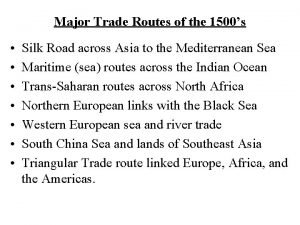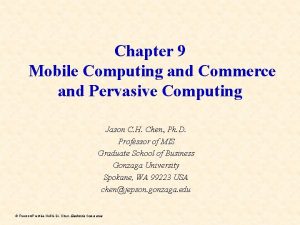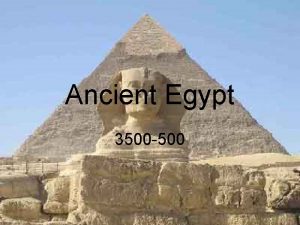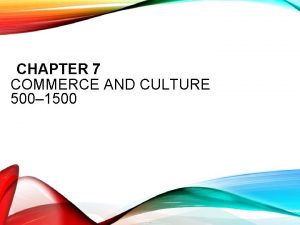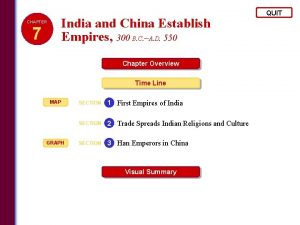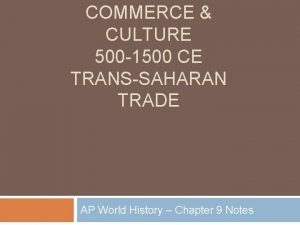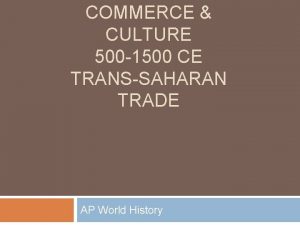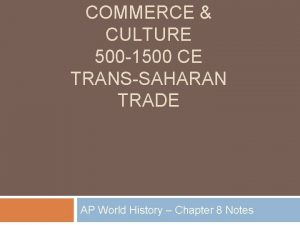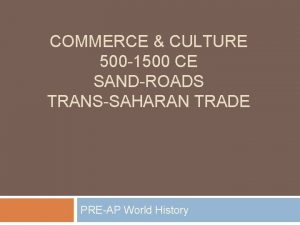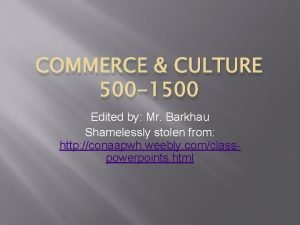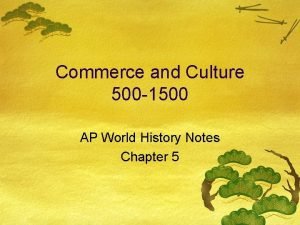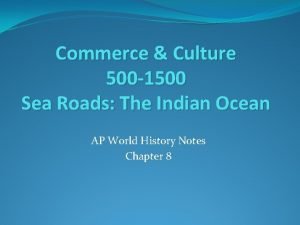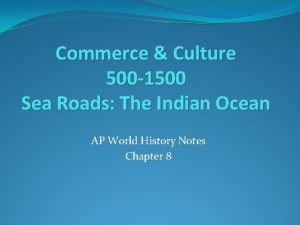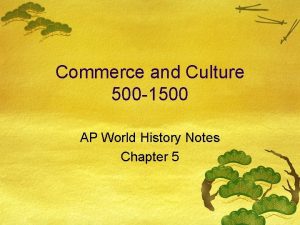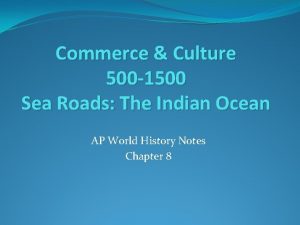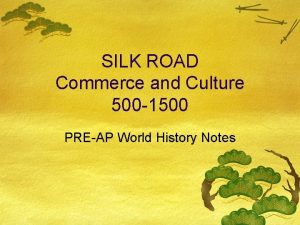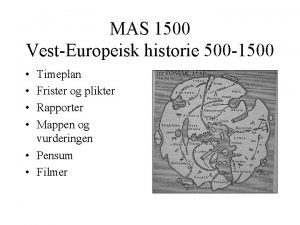COMMERCE CULTURE 500 1500 CE TRANSSAHARAN TRADE AP

















- Slides: 17

COMMERCE & CULTURE 500 -1500 CE TRANS-SAHARAN TRADE AP World History – Chapter 8 Notes

The Sand Roads Trans-Saharan trade route Linked North Africa and the Mediterranean world with West Africa

Trans-Saharan Trade Like the Silk and Sea Roads this trade begins as a result of environmental variation What does each region have to offer? � North African coastal areas = cloth, glassware, weapons, books � Sahara region = copper and salt � Savanna grasslands = grain crops

Trans-Saharan Trade Made possible by the CAMEL! 1 st traders = camel-owning people from desert oases Major traders became = North African Muslim Arabs What did they come to West Africa and sub-Saharan Africa for? � GOLD!, ivory, kola nuts, slaves � Gave in return: SALT!, horses,

Caravans As many as 5, 000 camels Hundreds of people Travelling at night Length of journey = about 70 days 15 -20 miles walked per day

Construction of Empires New wealth and resources from trans-Saharan trade allowed some regions to construct large empires or city-states Between 500 and 1600 CE Major empires = Mali, Ghana, and Songhai

West African Empires All monarchies Drew upon wealth of trans. Saharan trade Relied on slaves � Females used as = domestic servants and sex slaves � Males used as = state officials, craftsmen, miners, agricultural laborers

Cities Within the Kingdoms Urban and commercial centers � Traders met and exchanged goods there Centers of manufacturing � Items created: beads, iron tools, cotton textiles, etc. Mosque in Timbuktu (in Mali) Largely Islamic


Document A illustrates the political and economic power of the great Malian King and the difficulty of organizing and managing such an arduous journey.

Document B was compiled to illustrate the vast resources traded and traveled in the course of the thousands of miles journey in attempt to convey the impoetance of Tran-Saharan trade.

In Doc # C 26 years after Mansa passed through this town, Arab historian Ibn Battutta remarks on the economic importance of salt production for Muslim travelers to understand its integral importance for Tran-Saharan trade

Doc # D is a Jewish Mapmaker’s view of the legendary Mansa Musa and his Kingdom of Gold. The purpose of this documents is to highlight the source of the abundant supply of the world’s gold in an attempt to encourage trade ties across the Sahara whilst most Europeans did not travel into the interior of Africa

In Doc E, This Arab scholars interview both illustrates the economic and political lpower of the great African king both his piety and his unwillingness to kiss the hand of the sultan to exalt his notoriety and shed light on a man whose legend was kept by griots.

The primary source in Document # E helps evaluate the importance of almsgiving in Islam and Why Mansa was so generous and perhaps why he distributed so much of his wealth that Gold became devalued in Cairo for 20 years.

Thesis From 1200 -1450, the Tran-Saharan trade network was best illsutraed in the power of the Mailian Empire and its richest King, Mansa Musa. The travel of 60, 000 plus people over 4, 000 of desert routes illustrated his immeasurable political power, his generosity and goods carried the wealth of his empire and the influence of Islam on the impact of this religion integrated into its trading networks.

Synthesis Musa would be considered ( based on his gold reserves) the richest man in the world valued at over 400 Billion dollars. Like many wealthy individuals, he redistributed his income by giving it away ( Bill Gates, John D Rockefeller, Andrew Carnegie) and helped so many others. Mali’s wealth, however, would be challenged by the new Gold found in the Americas 14501750 and Mali would decline and fall within 3 generations after Mansa Musa.
 Trade routes 1500s
Trade routes 1500s Location-based commerce (l-commerce)
Location-based commerce (l-commerce) 3500 500
3500 500 Commerce and culture chapter 7
Commerce and culture chapter 7 Triangular trade
Triangular trade Trade diversion and trade creation
Trade diversion and trade creation Fair trade not free trade
Fair trade not free trade Trade diversion and trade creation
Trade diversion and trade creation Trade diversion and trade creation
Trade diversion and trade creation Trade diversion and trade creation
Trade diversion and trade creation Tramp and liner shipping
Tramp and liner shipping The trade in the trade-to-gdp ratio
The trade in the trade-to-gdp ratio China 300 bc
China 300 bc Anaerobic medium
Anaerobic medium Batch culture vs continuous culture
Batch culture vs continuous culture Robertson cooked meat medium
Robertson cooked meat medium Folk culture and popular culture venn diagram
Folk culture and popular culture venn diagram Folk culture and popular culture venn diagram
Folk culture and popular culture venn diagram
